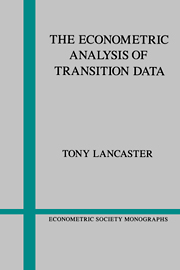Book contents
- Frontmatter
- Part I Model Building
- 1 Some Basic Results
- 2 Covariates and the Hazard Function
- 3 Parametric Families of Duration Distributions
- 4 Mixture Models
- 5 Some Important Processes
- 6 Some Structural Transition Models
- Part II Inference
- Appendix 1 The Gamma Function and Distribution
- Appendix 2 Some Properties of the Laplace Transform
- Bibliography
- Index
3 - Parametric Families of Duration Distributions
Published online by Cambridge University Press: 05 January 2013
- Frontmatter
- Part I Model Building
- 1 Some Basic Results
- 2 Covariates and the Hazard Function
- 3 Parametric Families of Duration Distributions
- 4 Mixture Models
- 5 Some Important Processes
- 6 Some Structural Transition Models
- Part II Inference
- Appendix 1 The Gamma Function and Distribution
- Appendix 2 Some Properties of the Laplace Transform
- Bibliography
- Index
Summary
Introduction and Overview
The theoretical basis for a specification of a hazard function is a model of optimal choice by the agents whose transitions are to be studied. Such a model can be specified in great detail leading to a hazard function that is determined by economic theory up to some set of unknown parameters. Or the investigator might abstain from such a detailed specification, choosing instead only to let economic theory suggest the relevant regressor variables and the probable directions of their effects. Both approaches have been used in the econometric literature. Sometimes the former is called a structural approach and the latter, rather disparagingly, a reduced form approach. There is, however, no clear distinction between them but rather only a difference of degree. In chapter 6 we shall give an account of some structural models whereas in this chapter and the next we shall be concerned with families of models whose functional form is not, precisely, dictated by economic-theoretical considerations, but which are convenient vehicles for an econometric investigation. Such families need to allow for the following facts:
The duration distributions of different people differ because, for example, they face different prices, have different wealth and income, and have differing stocks and types of human capital.
These sources of difference can be represented by a regressor vector, x, for each person, where x may have components which should, according to our economic theory, have been measured, but were not.
The regressor vector may have elements that are functions either of calendar time, for example, regressor values changing over the business cycle, or of duration, which is time measured from the date of entry to the state. An example is the stream of unemployment benefits, which in the British system used to vary both with the duration of unemployment and among persons. Thus we have, in general, x = x (t, s) where, say, t is duration and s calendar time. Though in our notation we shall sometimes suppress the possible time dependence of x, it must be borne in mind.
- Type
- Chapter
- Information
- The Econometric Analysis of Transition Data , pp. 33 - 57Publisher: Cambridge University PressPrint publication year: 1990



